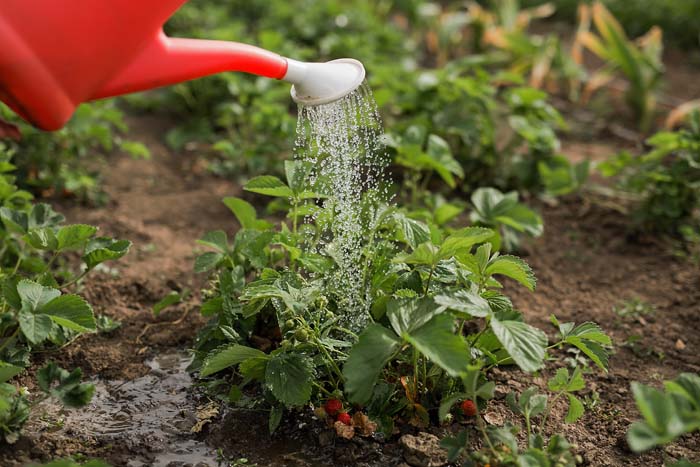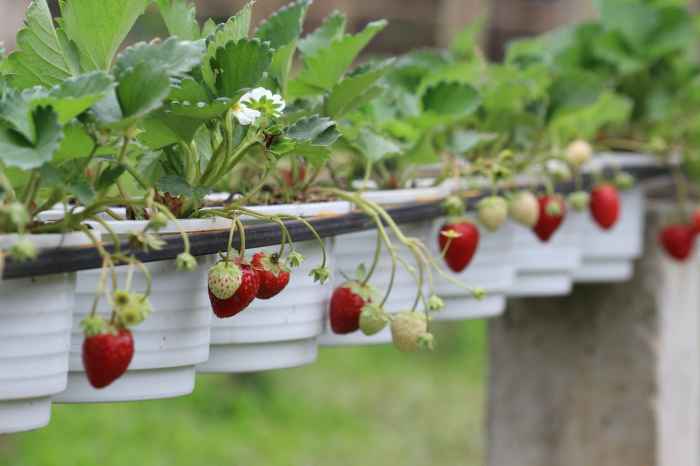How to Water Strawberry Plants
Watering Frequency for Strawberry Plants: How To Water Strawberry Plants
How to water strawberry plants – Consistent and appropriate watering is crucial for healthy strawberry growth and bountiful harvests. The ideal watering schedule depends on several factors, including the climate, the specific strawberry variety, and the growth stage of the plant. Understanding these factors will help you optimize your watering practices and achieve optimal results.
Ideal Watering Schedule Based on Climate and Growth Stage
In hot, dry climates, strawberries will require more frequent watering than in cooler, more humid regions. During the growing season (spring and summer), plants generally need more water than during dormancy (fall and winter). Newly planted strawberries require more frequent, but lighter watering to establish their root systems. During flowering and fruiting, consistent moisture is vital for optimal fruit development.
Reduce watering slightly as the plants approach dormancy to prevent overwatering and potential rot.
Watering Needs for Different Strawberry Varieties
While general guidelines exist, specific watering needs vary slightly among different strawberry varieties. June-bearing strawberries, for example, have a more concentrated fruiting period, requiring consistent watering during this time. Everbearing and day-neutral varieties, which produce fruit over a longer period, may need a more balanced watering schedule throughout the growing season. Consult specific variety information for more detailed recommendations.
Adjusting Watering Frequency Based on Soil Moisture
The best indicator of watering needs is the soil moisture level. Before watering, check the soil depth of about an inch below the surface. If it feels dry, it’s time to water. Overwatering can lead to root rot, while underwatering can cause wilting and reduced yields. Regularly monitoring soil moisture helps you avoid both extremes.
Watering Frequency Chart
| Climate | Growth Stage | Soil Type | Watering Frequency (Days) |
|---|---|---|---|
| Hot & Dry | Growing Season | Sandy | 1-2 |
| Hot & Dry | Growing Season | Clay | 3-4 |
| Moderate | Growing Season | Sandy | 2-3 |
| Moderate | Growing Season | Clay | 4-5 |
| Cool & Humid | Growing Season | Sandy | 3-4 |
| Cool & Humid | Growing Season | Clay | 5-7 |
Watering Methods for Strawberry Plants
Several methods can be used to water strawberry plants, each with its own advantages and disadvantages. Selecting the best method depends on factors like the size of your strawberry patch, your available resources, and your personal preferences.
Different Watering Methods and Their Comparison
Common watering methods include drip irrigation, soaker hoses, and overhead watering. Drip irrigation delivers water directly to the plant’s roots, minimizing water waste and reducing the risk of fungal diseases. Soaker hoses provide a gentle, consistent watering, but may not be suitable for large areas. Overhead watering is the simplest method, but can lead to leaf diseases if not done carefully.
Best Practices for Each Watering Method
Regardless of the method chosen, avoid wetting the foliage whenever possible to prevent fungal diseases. For drip irrigation, ensure emitters are placed close to the plants but not touching them. With soaker hoses, lay them along the rows, ensuring even water distribution. Overhead watering should be done early in the day to allow foliage to dry before nightfall.
Setting Up a Drip Irrigation System
- Plan the layout of your drip irrigation system, considering the spacing of your strawberry plants.
- Purchase the necessary materials: a water source, tubing, emitters, connectors, and a pressure regulator (if needed).
- Connect the tubing to the water source and install the emitters at appropriate intervals along the rows.
- Test the system to ensure proper water flow and emitter functionality.
- Adjust the water pressure and emitter flow rate as needed to provide adequate but not excessive watering.
Signs of Underwatering and Overwatering

Source: decorhomeideas.com
Recognizing the signs of both underwatering and overwatering is crucial for maintaining healthy strawberry plants. Early detection allows for timely corrective action, preventing significant damage and yield reduction.
Visual Cues of Underwatering
Underwatered strawberry plants often exhibit wilting leaves, especially during the hottest parts of the day. The leaves may appear dull and dry, and the soil will feel dry to the touch. Fruit production may be reduced, and the overall plant vigor will be diminished.
Visual Cues of Overwatering
Overwatered plants often show yellowing leaves, especially the lower ones. The soil will be soggy and may have a foul odor. The plants may appear stunted or leggy. Severe overwatering can lead to root rot, a fatal condition for strawberry plants.
Consequences of Improper Watering
Both underwatering and overwatering can significantly impact plant health and yield. Underwatering stresses the plants, leading to reduced fruit size and quantity. Overwatering creates an environment conducive to fungal diseases, ultimately killing the plants. Maintaining proper soil moisture is key to healthy growth and optimal yields.
Comparing Symptoms of Underwatering and Overwatering
| Symptom | Underwatering | Overwatering |
|---|---|---|
| Leaves | Wilting, dry, dull | Yellowing, soggy |
| Soil | Dry | Soggy, potentially foul-smelling |
| Growth | Stunted | Stunted, leggy |
| Fruit | Reduced yield, small fruit | Reduced yield, potential rot |
Soil Considerations for Strawberry Hydration
The soil plays a vital role in maintaining optimal hydration for strawberry plants. Proper soil structure ensures good drainage and aeration, preventing waterlogging while also retaining sufficient moisture.
Ideal Soil Conditions for Strawberry Plants
Strawberries thrive in well-drained, slightly acidic soil (pH 6.0-6.5). Sandy loam soil is ideal because it offers good drainage while still retaining some moisture. Heavy clay soils should be amended to improve drainage and aeration. Avoid planting strawberries in poorly drained areas where water can accumulate.
Importance of Soil Drainage and Aeration
Good drainage prevents waterlogging, which can suffocate roots and lead to root rot. Aeration allows for proper oxygen flow to the roots, essential for healthy growth. Compacted soils should be loosened to improve both drainage and aeration.
Amending Soil for Better Water Retention and Drainage
Amend heavy clay soils with organic matter such as compost or peat moss to improve drainage and water retention. For sandy soils, add organic matter to increase water retention capacity. Soil testing can help determine the specific amendments needed to optimize your soil’s properties.
Testing Soil Moisture Levels

Source: ytimg.com
The simplest method is the finger test: insert your finger about an inch into the soil. If it feels dry, it’s time to water. More precise measurements can be obtained using a soil moisture meter, which provides a numerical reading of soil moisture content.
Water Quality’s Impact on Strawberry Plants
The quality of the water used for irrigation significantly impacts the health and productivity of strawberry plants. Certain elements in water can be detrimental to plant growth, while others can be beneficial.
Effects of Water Quality on Strawberry Health
High levels of chlorine or minerals in water can damage plant roots and affect nutrient uptake. Chlorine can burn delicate plant tissues, while excessive minerals can lead to salt buildup in the soil, hindering growth. Hard water, with high mineral content, can also negatively affect plant health.
Improving Water Quality for Irrigation
Allowing water to sit for 24 hours before using it helps dissipate chlorine. Using a water filter can remove chlorine and other impurities. Consider using rainwater whenever possible, as it’s naturally free of chlorine and many minerals.
Potential Water Quality Issues and Solutions
- High Chlorine: Let water sit for 24 hours or use a water filter.
- High Mineral Content (Hard Water): Consider using rainwater or a water softener.
- High Salt Content: Flush the soil with clean water to leach out excess salts.
- pH Imbalance: Adjust soil pH using appropriate amendments.
Watering During Different Growth Stages
Watering needs change throughout the strawberry plant’s life cycle. Adjusting watering techniques based on the growth stage is essential for optimal plant health and fruit production.
Watering Needs During Planting, Flowering, and Fruiting
Newly planted strawberries require frequent, light watering to establish their root systems. During flowering, consistent moisture is vital for blossom development. Fruiting requires ample water for optimal fruit size and quality. Reduce watering slightly as the plants approach dormancy to prevent overwatering and potential rot.
Adjusting Watering Techniques Based on Growth Stage
During the early stages, focus on consistent moisture without overwatering. As plants mature and produce fruit, increase watering frequency and volume, but avoid waterlogging. Reduce watering as the plants approach dormancy to allow the soil to dry slightly.
Environmental Factors Affecting Watering Needs, How to water strawberry plants
Hot, dry conditions necessitate more frequent watering than cool, humid conditions. Windy conditions can increase water loss from the soil, requiring more frequent irrigation. Shade can reduce the rate of evaporation, potentially reducing watering needs.
Visual Representation of Ideal Watering Techniques
Imagine a visual guide with three sections representing the three main growth stages (planting, flowering, fruiting). Each section would show a strawberry plant at that stage, with accompanying text describing the appropriate watering frequency, method, and soil moisture level to aim for. The visual would clearly demonstrate the shift in watering needs from the establishment phase to the fruiting phase, culminating in a slight reduction as the plants approach dormancy.
Troubleshooting Watering Problems

Source: co.uk
Proper watering is crucial for healthy strawberry plants; aim for consistent moisture without overwatering. To boost your plants’ potassium levels, consider supplementing with nutrient-rich water, such as learning how to make a fantastic fertilizer by checking out this guide on how to make banana peel water for plants. This natural fertilizer can help enhance fruit production and overall plant vigor, ensuring your strawberries thrive.
Remember to water deeply but infrequently, allowing the soil to dry slightly between waterings.
Despite best efforts, watering problems can occur. Quick identification and resolution of these issues are critical for maintaining healthy and productive strawberry plants.
Common Watering Problems and Their Solutions
Wilting can indicate both underwatering and overwatering. Yellowing leaves often point to overwatering or nutrient deficiencies. Poor fruit production can result from inconsistent watering or inadequate soil moisture. Addressing these issues requires careful observation and appropriate corrective actions.
Preventing Future Watering Issues
Regularly monitor soil moisture, using the finger test or a moisture meter. Choose an appropriate watering method for your conditions and adjust watering frequency based on weather conditions and plant growth stage. Ensure proper soil drainage and aeration to prevent waterlogging. Mulching can help retain soil moisture and reduce evaporation.
Troubleshooting Guide for Watering Problems
| Problem | Cause | Solution | Prevention |
|---|---|---|---|
| Wilting | Underwatering or Overwatering | Adjust watering frequency and method | Monitor soil moisture regularly |
| Yellowing Leaves | Overwatering, Nutrient Deficiency | Improve drainage, adjust fertilization | Avoid overwatering, test soil regularly |
| Poor Fruit Production | Inconsistent Watering, Nutrient Deficiency | Ensure consistent moisture, adjust fertilization | Maintain consistent soil moisture, fertilize appropriately |
| Root Rot | Overwatering, Poor Drainage | Improve drainage, reduce watering | Choose well-drained soil, avoid overwatering |
FAQ Resource
What type of water is best for strawberries?
Rainwater is ideal. If using tap water, let it sit overnight to allow chlorine to dissipate. Avoid using extremely hard water.
How often should I check the soil moisture?
Check daily, especially during hot, dry periods. Use your finger to test the top inch of soil; if it feels dry, it’s time to water.
My strawberry leaves are turning yellow; what should I do?
Yellowing leaves can indicate overwatering or underwatering. Check the soil moisture and adjust your watering schedule accordingly. Rule out other potential causes like nutrient deficiencies.
Can I use overhead watering for strawberries?
Overhead watering can lead to fungal diseases. While acceptable occasionally, it’s best to use methods like drip irrigation or soaker hoses to avoid wetting the foliage.




















